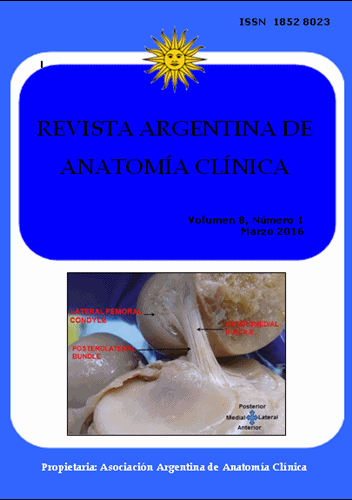ANASTOMOSIS ENTRE LA RAMA PROFUNDA DEL NERVIO CUBITAL Y EL NERVIO MEDIANO EN LA MANO. Anastomosis between the deep branch of the ulnar nerve and the median nerve in the hand
DOI:
https://doi.org/10.31051/1852.8023.v8.n1.14207Keywords:
Riche-Cannieu anastomosis, thenar branch, thenar eminence, hand, motor innervation, Anastomosis de Riche-Cannieu, rama tenar, eminencia tenar, mano, inervación motoraAbstract
Introducción: La anastomosis de Riche-Cannieu (ARC) es una variación anatómica formada entre la rama tenar del nervio mediano (NM) y la rama profunda del nervio cubital (NC). Debido a la importancia clínica y electromiográfica su descripción anatómica es de gran interés, ya que debido a esta variación anatómica existen distintas formas de inervación motora a nivel de la mano. Materiales y Métodos: Se realizaron disecciones cadavéricas en 38 manos (19 cadáveres) de ambos sexos formolizados en solución al 5 %, de entre 50 y 70 años de edad. Se utilizó instrumental y técnicas convencionales de disección. Resultados: En la rama profunda del NC no se evidenciaron variaciones y finalizaba su recorrido en el músculo aductor del pulgar. En el 86,84% de los casos emerge una rama que se anastomosa con el NM de diferentes formas. Esta rama anastomótica, en el 50% de las manos, era una arcada nerviosa de considerable calibre entre el NC y NM, que daba ramas motoras a los músculos de la eminencia tenar. Discusión: El conocimiento de esta anastomosis es muy importante ya que, en casos de lesión del nervio mediano o cubital, puede causar confusión clínica, quirúrgica y en los hallazgos electromiográficos. Debido a su alta frecuencia fue considerada un rasgo anatómico normal.
Introduction: The Riche-Cannieu anastomosis (RCA) is an anatomic variation formed between the thenar branch of the median nerve and the deep branch of the ulnar nerve. Its anatomical description is of great interest because of its clinical and electromyographic relevance. Due to the RCA, there are various types of hand motor innervation. Materials and Methods: Thirty eight hands from 19 corpses (formolized in a 5% solution) whose ages ranged from 50 to 70 years old were dissected. Conventional instruments and techn-iques were used. Results: The pathway of the deep branch of the ulnar nerve did not show variations and ended at the adductor pollicis muscle. In 86.84% of the cases a branch emerged there and anastomosed the median nerve by different modalities. A nervous arcade of considerable important size was observed between the ulnar and median nerve in 50 % of the anastomosis and it gave motor branches for the thenar muscles. Discussion: It is of great importance to learn about this anastomosis because of the possibility of median or ulnar nerve injuries; it may cause clinical, surgical or electromyographic confusion. Due to its high frequency, it was regarded as a normal connection.
References
Ajmani ML. 1996. Variations in the motor nerve supply of the thenar and hypothenar muscles of the hand. J Anat 189: 145-50.
Boland RA, Krishnan AV, Kiernan MC. 2007. Riche-Cannieu anastomosis as an inherited trait. Clinical Neurophysiology 118: 770-75.
Brown JV, Landau ME. 2013. Sparing of the Second Lumbrical in a Riche- Cannieu Anast-omosis: The Nearly All- Ulnar Hand. Lippincott Williams & Wilkins 14: 184-87.
Gozkea E, Gurerb R, Gurbuzera N. 2012. Riche- Cannieu Anastomosis: A Case Report. J Med Case 3: 195-96.
Harness D, Sekeles E. 1971. The double anastomotic inervation of thenar muscles. J Anat 3: 461-66.
Homma T, Sakai T. 1992. Thenar and hypothenar muscles and their innervation by the ulnar and median nerves in the human hand. ActaAnat (Basel) 145: 44-49.
Iyer V, Fenichel GM. 1976. Normal median nerve proximal latency in carpal tunnel syndrome: a clue to coexisting Martin- Gruber anastomosis. Journal of Neurology, Neurosurgery, and Psiquiatry 39: 449-52.
Kimura I, Ram Ayyar D, Lippmann SM. 1983. Electrophysiological verification of the ulnar to median nerve communications in the hand and forearm. Tohoku J exp Med 141: 269-74.
Loukas M, Louis RG, Stewart L, Hallner B, DeLuca T, Morgan W, Shah R, Mlejnek J. 2007. The surgical anatomy of ulnar and median nerve communications in the palmar surface of the hand. J Neurosurg 106: 887-93.
Pardal Fernández JM, Guerrero Solano JL, Godes Medrano B, Sánchez Honrubia RM. 2012. Inervación anómala múltiple de la mano en una paciente. Diagnóstico electrofisiológico. Rev Neurol 54: 343-48.
Rotman MB, Donovan JP. 2002. Practical anatomy of the carpal tunnel. Hand Clin 18: 219-30.
Sirasanagandla SR, Patil J, Potu BK, Nayak BS, Shetty SD, Bhat KMR. 2013. A rare anatomical variation of the Berrettini anastomosis and third common palmar digital branch of the median nerve. Anat Sci Int 88: 136-66.
Stancic MF, Eskinja N, Stosic A. 1995. Anat-omical variations of the median nerve in the carpal tunnel. International Orthopaedics (SICOT) 19: 30-34.
Testut L, Latarjet A. 1973. Tratado de Anatomía Humana. 8va Edición, Barcelona: Salvat Editores, pág.: 1-1172.
Unver Dogan N, Ilknur Uysal I, Seker M. 2009. The communications between the ulnar and median nerves in upper limb. Neuroanatomy 8: 15-19.
Williams PL, Warwick R. 1992. Gray Anatomía. Madrid: Churchill Livingstone.
Downloads
Published
Issue
Section
License
Authors retain copyright and grant the journal right of first publication with the work simultaneously licensed under a Creative Commons Attribution License that allows others to share the work with an acknowledgement of the work's authorship and initial publication in this journal. Use restricted to non commercial purposes.
Once the manuscript has been accepted for publications, authors will sign a Copyright Transfer Agreement to let the “Asociación Argentina de Anatomía Clínica” (Argentine Association of Clinical Anatomy) to edit, publish and disseminate the contribution.



